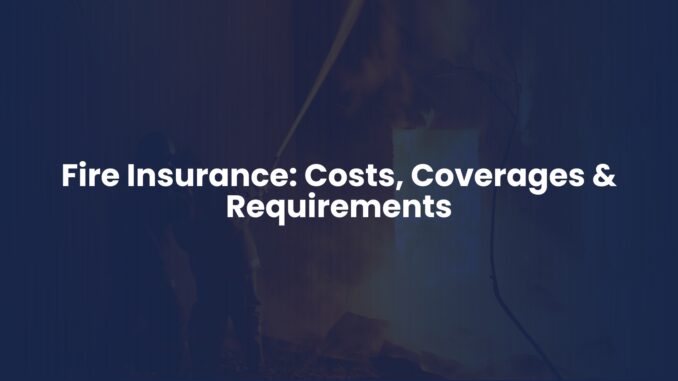
What Is Fire Insurance?
Fire insurance is a specialized insurance policy designed to cover losses or damages caused by fire-related incidents. This coverage typically includes damage to the structure of your property, personal belongings, and related expenses caused by fire outbreaks.
Importance of Fire Insurance
Fire damage can be devastating, leading to costly repairs or complete loss of property. Fire insurance safeguards homeowners and business owners from significant financial burden and helps them recover faster after a fire event.
What Does Fire Insurance Cover?
Structural Damage Coverage
Covers the costs of repairing or rebuilding your home or business structure damaged by fire, smoke, or related hazards.
Personal Property Protection
Protects your belongings such as furniture, electronics, clothing, and other valuables lost or damaged due to fire.
Additional Living Expenses
Pays for temporary housing, food, and other expenses if your home is uninhabitable during repairs.
Liability Coverage
Covers legal expenses if someone is injured in your property because of fire or related incidents.
Fire Insurance Costs in 2025
Average Premiums by Region
| Region | Average Annual Premium |
|---|---|
| Northeast US | $800 |
| Midwest US | $600 |
| South US | $700 |
| West US | $750 |
Factors Influencing Fire Insurance Costs
- Location risk (wildfires, urban density)
- Building materials and age
- Safety features (sprinklers, alarms)
- Coverage limits and deductibles
- Claims history
Legal Requirements for Fire Insurance
Fire Insurance and Mortgages
Most mortgage lenders require proof of fire insurance to protect their investment in the property.
Fire Insurance in Different States
Requirements vary by state; some states mandate fire insurance for specific property types or mortgage conditions.
How to Choose the Right Fire Insurance Policy
Assessing Your Coverage Needs
Evaluate the value of your home and belongings to ensure adequate coverage. Consider risks specific to your area, like wildfire or urban fire hazards.
Comparing Policies and Providers
Look beyond price: check coverage limits, exclusions, claim service reputation, and policy terms before choosing.
Tips to Reduce Your Fire Insurance Premium
Safety Measures That Help Lower Costs
- Install smoke detectors and fire alarms
- Maintain fire extinguishers
- Use fire-resistant building materials
- Clear brush and debris around property
Discounts and Bundling Options
- Multi-policy discounts (home and auto)
- Loyalty discounts for long-term customers
- Discounts for security system installation
How to File a Fire Insurance Claim
Step-by-Step Claims Process
- Ensure safety and call emergency services
- Document damage with photos and videos
- Notify your insurer immediately
- Complete the claim form with details
- Cooperate with the claims adjuster inspection
- Keep receipts for any emergency repairs or living expenses
- Review and accept settlement offer
What to Expect During Claims
Insurers investigate the cause and extent of damage. Claims processing times vary but typically take days to weeks depending on complexity.
Conclusion
Fire insurance is a vital protection that helps homeowners and business owners recover financially from fire-related damages. Understanding coverage options, costs, and legal requirements allows you to make informed decisions and protect your property effectively. Always evaluate your policy regularly and implement safety measures to minimize risk and premiums.

Leave a Reply